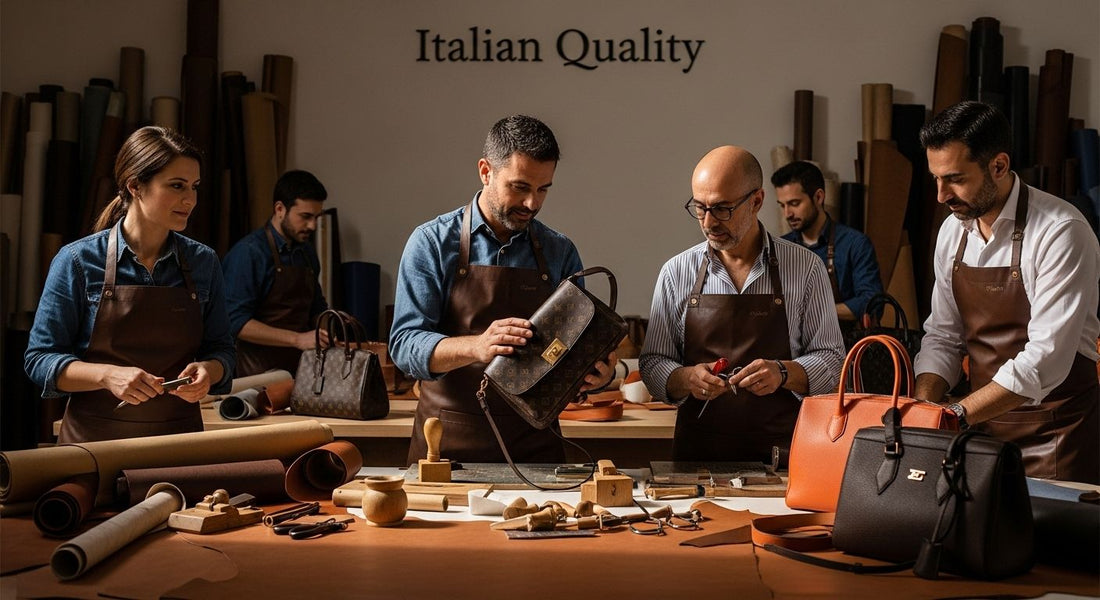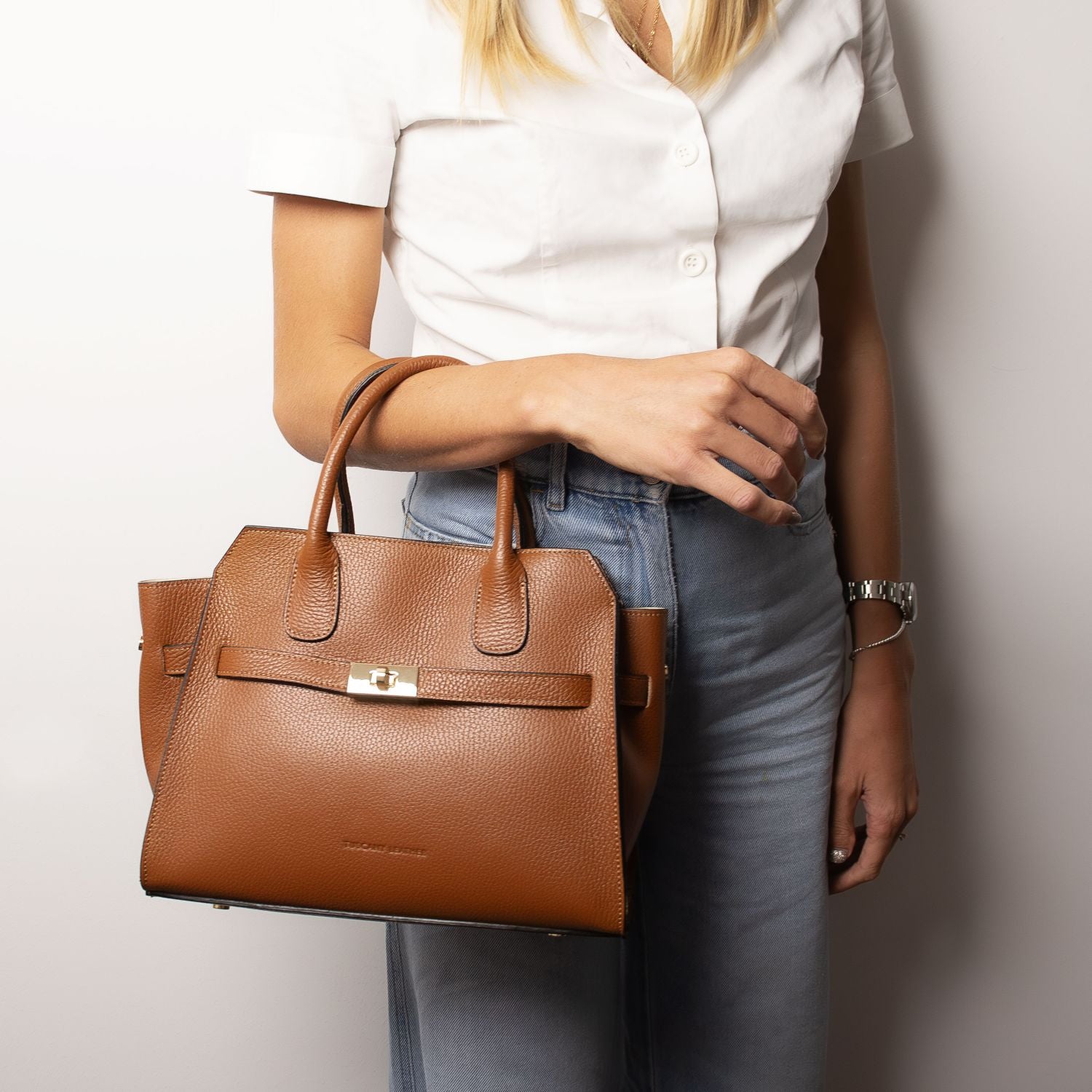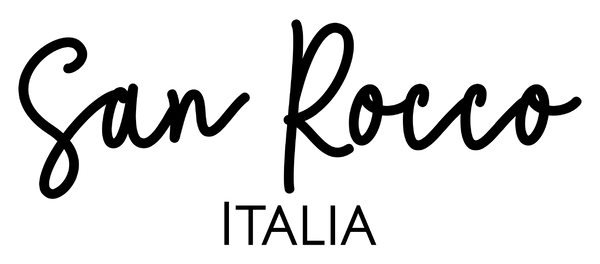
Best Leather for Handbags: Italian Quality and Timeless Style
Share

Italian leather handbags are celebrated for their elegance and craftsmanship, often topping wishlists of collectors and designers worldwide. Yet while luxury brands might shout about style, it is the heritage that truly sets them apart. Italian tanneries still uphold 11 strict criteria of artistry passed down for centuries, but the real surprise is how new technology like nanocollagen is quietly transforming these timeless pieces with exceptional durability. The beauty is obvious, but the science behind it is what most never see coming.
Table of Contents
- Italian Leathers: Heritage And Excellence
- Comparing Leather Types For Handbags
- Choosing Durable And Sustainable Leather
- Why Handbag Collectors Love Artisanal Italian Leather
Quick Summary
| Takeaway | Explanation |
|---|---|
| Italian leather embodies rich heritage and craftsmanship. | Italian leather is a symbol of centuries of artisanal skill and cultural legacy, making it a highly valued material for handbags. |
| Consider leather type for functionality and style. | Full-grain, top-grain, and suede each have distinct properties that impact durability and aesthetic, guiding consumers in their choice. |
| Sustainable production is key to ethical choices. | Modern tanneries focus on environmentally responsible practices, ensuring that luxury production aligns with sustainable values. |
| Artisanal pieces are a worthwhile investment. | Collectors value handcrafted bags not just for beauty, but for their craftsmanship and cultural significance, making them enduring investments. |
| Innovation enhances traditional craftsmanship. | Techniques like nanotechnology improve leather durability while preserving artisanal traditions, bridging the past with modern performance needs. |
Italian Leathers: Heritage and Excellence
The world of Italian leather represents more than just a material. It embodies a profound narrative of craftsmanship, cultural heritage, and unparalleled skill that has been meticulously cultivated over centuries. Italian leather is not simply a product but a testament to generations of artisanal expertise, where each piece tells a story of tradition, innovation, and extraordinary dedication.
The Cultural Roots of Italian Leather Craftsmanship
Italian leather craftsmanship traces its origins back to medieval guilds in regions like Tuscany, where leather working was considered a noble art form. The Michelangelo Foundation’s research reveals that contemporary artisans still adhere to 11 rigorous criteria of excellence, ensuring that each piece maintains the highest standards of quality and authenticity.
Traditional techniques passed down through generations have transformed leather production from a mere manufacturing process into an intricate art. Skilled craftsmen understand that true quality emerges not just from technical proficiency but from a deep respect for materials and ancestral knowledge. Their hands carry the wisdom of countless predecessors, translating complex cultural memories into tangible, exquisite products.
Sustainability and Ethical Production
Modern Italian leather production goes far beyond aesthetic excellence. UNIC’s 2020 Sustainability Report highlights the industry’s commitment to environmental responsibility. Tanneries are increasingly implementing advanced waste reduction techniques and developing transparent supply chain practices that respect both ecological and human welfare standards.
This commitment reflects a profound understanding that luxury cannot exist in isolation from environmental and social considerations. Italian leather producers are pioneering methods that balance traditional craftsmanship with contemporary ethical standards, proving that heritage and progress can coexist harmoniously.
Innovation Meets Tradition
The extraordinary narrative of Italian leather is also one of continuous innovation. As research analyzing Salvatore Ferragamo’s corporate museum demonstrates, brands are not just preserving history but actively reinterpreting it. By carefully studying historical techniques while embracing modern technologies, Italian leather artisans create products that are simultaneously timeless and contemporary.
Each piece of Italian leather represents a delicate balance between respect for traditional methods and an openness to technological advancement. This dynamic approach ensures that Italian leather remains at the forefront of global luxury, continuously evolving while maintaining its core essence of exceptional quality and unparalleled craftsmanship.
Comparing Leather Types for Handbags
Selecting the right leather for a handbag involves understanding the nuanced characteristics of different leather types. Each variety offers unique properties that influence durability, aesthetic appeal, and overall performance, making the selection process critical for discerning fashion enthusiasts.
Full-Grain Leather: The Premium Choice
Full-grain leather represents the pinnacle of leather quality, retaining the entire grain layer without surface alterations. This unaltered state provides exceptional strength and remarkable longevity. As noted in leather research, full-grain leather develops a distinctive patina over time, which enhances its visual character and tells a unique story of use and elegance.
The natural imperfections and markings in full-grain leather are not viewed as flaws but as hallmarks of authenticity. Each handbag becomes a testament to the individual animal’s history, with subtle variations that make every piece truly one of a kind. Craftsmen prize this leather type for its ability to withstand rigorous daily use while maintaining structural integrity and aesthetic appeal.
Top-Grain Leather: Refined and Versatile
Top-grain leather emerges as an exceptional alternative for those seeking a balance between quality and practicality. Derived from the outer hide layer, this leather type features densely packed fibers that contribute to its remarkable strength and durability. Unlike full-grain leather, top-grain undergoes slight surface refinement, creating a more uniform appearance while preserving the material’s inherent robustness.
One significant advantage of top-grain leather is its enhanced resistance to water and environmental factors. The surface treatment provides additional protection, making it less susceptible to discoloration and shape distortion. This makes top-grain leather an ideal choice for handbags designed for professionals and individuals who require a reliable, low-maintenance accessory.
Suede: Soft Luxury with Specific Considerations
Suede leather, crafted from the underside of animal hides, offers a dramatically different tactile experience. Characterized by its soft, napped finish, suede provides a luxurious texture that appeals to those seeking a more delicate aesthetic. Typically sourced from younger or smaller animals to ensure a fine, smooth surface, suede requires more careful maintenance compared to its more robust counterparts.
While suede handbags exude elegance and sophistication, they demand more attentive care. The delicate nature of the material makes it more susceptible to staining and water damage, necessitating protective treatments and mindful usage. Suede works exceptionally well for evening bags or occasional-use accessories where its unique texture can be showcased without extensive wear and tear.
Understanding these leather types empowers consumers to make informed decisions that align with their lifestyle, aesthetic preferences, and functional requirements.
To help readers compare the main types of leather used in handbags, the following table summarises their key characteristics, strengths, and ideal uses as discussed in the article.
| Leather Type | Key Properties | Strengths | Ideal Use Cases |
|---|---|---|---|
| Full-Grain | Retains entire grain, natural imperfections | Exceptional durability, develops a unique patina | Everyday handbags, collectors’ pieces |
| Top-Grain | Refined surface, densely packed fibres | Uniform appearance, water-resistant, strong | Professional, low-maintenance bags |
| Suede | Soft, napped finish from underside of hide | Luxurious texture, elegant look | Evening/occasional-use bags |

Whether prioritizing durability, refined appearance, or luxurious texture, there exists a leather type perfectly suited to individual needs.

Choosing Durable and Sustainable Leather
Durability and sustainability have become paramount considerations in contemporary leather selection, particularly for discerning consumers seeking high-quality handbags that align with ethical and environmental principles. The journey towards selecting leather that combines longevity with responsible production requires a nuanced understanding of material properties, manufacturing processes, and environmental impact.
Advanced Material Science in Leather Durability
Research from the Istituto Centrale per il Restauro reveals groundbreaking developments in leather enhancement through nanotechnology. Innovative techniques like applying synthesized nanocollagen can significantly improve leather’s mechanical properties, increasing its shrinkage temperature and overall structural integrity. This scientific approach transforms leather from a traditional material into a high-performance substrate that maintains exceptional durability.
Modern leather production now integrates advanced research to extend material lifecycle. Craftsmen and scientists collaborate to develop techniques that reinforce leather’s natural characteristics, ensuring that handbags can withstand extensive use while maintaining their aesthetic appeal. These technological interventions represent a sophisticated approach to preserving leather’s inherent qualities.
Sustainable Production Principles
Frontiers in Sustainability research highlights a critical consumer preference for naturally appearing leather with reduced chemical interventions. This trend underscores a growing demand for production methods that minimise environmental impact while preserving leather’s authentic characteristics.
Sustainable leather production encompasses multiple dimensions. This includes responsible sourcing of animal hides, implementing water-conservation techniques during tanning, reducing chemical treatments, and ensuring fair labour practices. Manufacturers increasingly recognise that sustainability is not merely an environmental consideration but a comprehensive approach to ethical production.
Practical Considerations for Conscious Consumers
Choosing sustainable and durable leather requires careful evaluation beyond aesthetic appeal. Consumers should consider factors such as the leather’s origin, tanning processes, and the manufacturer’s environmental commitments. Look for certifications indicating responsible production, such as those addressing water usage, chemical management, and worker welfare.
Key indicators of quality and sustainability include minimal chemical processing, transparent supply chains, and production methods that prioritise both environmental and human welfare. A truly exceptional leather handbag represents more than a fashion statement it embodies a commitment to responsible consumption and appreciation for craftsmanship that respects both natural resources and human expertise.
For those prioritising ethical and sustainable choices, the table below organises the key aspects of sustainable leather production highlighted in the article. It summarises both the principles and practical indicators that conscious consumers should consider.
| Sustainability Aspect | Description / Key Focus |
|---|---|
| Responsible Sourcing | Using ethically obtained animal hides |
| Water Conservation | Implementing tanning processes that lower water use |
| Reduced Chemical Use | Minimising chemicals in processing; prefer naturally appearing leather |
| Fair Labour Practices | Ensuring proper working conditions and rights |
| Supply Chain Transparency | Clear, open information on sourcing and production |
| Quality and Durability | Producing long-lasting handbags to reduce waste |
By understanding these complex considerations, consumers can make informed choices that support both exceptional product quality and broader environmental stewardship. The future of leather production lies in this delicate balance between technological innovation, traditional craftsmanship, and ecological responsibility.
Why Handbag Collectors Love Artisanal Italian Leather
Artisanal Italian leather represents more than a material choice it embodies a profound cultural legacy of craftsmanship, innovation, and unparalleled aesthetic sophistication. Handbag collectors worldwide are drawn to these exceptional pieces not merely as accessories, but as expressions of artistic heritage and meticulous skill.
The Unique Value of Authentic Craftsmanship
The ‘Made in Italy’ label serves as a rigorous guarantee of authenticity, ensuring that products are entirely conceived, manufactured, and packaged within Italian territory. This regulation protects the intrinsic value of traditional manufacturing and represents a commitment to maintaining the highest standards of production.
Each artisanal leather handbag tells a story of generational expertise. Craftsmen train for years, sometimes decades, perfecting techniques passed down through family workshops. This deep connection to tradition means that every stitch, cut, and finish represents a living connection to Italy’s rich cultural narrative. Handcrafted precision transforms these handbags from mere accessories into collectible art pieces.
Navigating Market Challenges with Innovation
Recent reporting from Reuters highlights the challenges facing Tuscan leather manufacturers, including shifting global demand and evolving market trends. These challenges have paradoxically strengthened the resolve of artisan leather producers, pushing them to innovate while maintaining their core commitment to exceptional quality.
Innovation in Italian leather production goes beyond traditional methods. Research on leather preservation demonstrates how advanced techniques like nanocollagen application can enhance leather’s mechanical properties, increasing elasticity and durability. This scientific approach ensures that artisanal leather handbags are not just beautiful but also engineered for longevity.
Collecting Beyond Aesthetics
For serious collectors, an artisanal Italian leather handbag represents more than a fashion statement. It is an investment in cultural heritage, a tangible connection to a centuries-old tradition of excellence. The rarity of truly handcrafted pieces, combined with their exceptional quality, makes them highly sought after by discerning collectors who understand the nuanced value of authentic craftsmanship.
The appeal extends beyond immediate visual charm. Collectors appreciate the subtle imperfections that reveal human touch, the carefully selected materials, and the intricate processes that transform raw leather into a sophisticated accessory. Each handbag becomes a narrative of skill, tradition, and artistic expression.
Ultimately, artisanal Italian leather handbags transcend typical fashion cycles. They represent a timeless intersection of art, technology, and cultural identity, offering collectors not just an accessory, but a piece of living history crafted with unparalleled passion and expertise.
Frequently Asked Questions
What is the best type of leather for handbags?
The best types of leather for handbags include full-grain leather, known for its durability and unique patina, top-grain leather which offers a refined finish and practicality, and suede, which has a soft texture but requires more care.
How can I ensure I’m choosing sustainable leather?
To choose sustainable leather, look for products that source hides ethically, implement water conservation techniques during tanning, use minimal chemicals in production, and demonstrate transparency in their supply chains.
What distinguishes Italian leather from other types of leather?
Italian leather is renowned for its rich heritage, exceptional craftsmanship, and stringent quality standards. It combines traditional techniques with modern innovations, resulting in high-quality, durable products.
How do I maintain my leather handbag to ensure its longevity?
Maintain your leather handbag by cleaning it regularly with a soft cloth, keeping it away from direct sunlight and moisture, and using appropriate leather conditioners to preserve its quality and flexibility.
Experience Italian Leather Excellence With Confidence
Are you seeking a truly timeless handbag that captures the enduring heritage and quality detailed in our guide to the best leathers for handbags? If you have ever struggled to find accessories made with genuine full-grain leather, handcrafted by skilled artisans, and produced with sustainability in mind, it is time to discover a better solution. Many brands compromise on authenticity or production methods, but you deserve leather goods that are both beautiful and responsibly made. At San Rocco Italia, every handbag is a testament to Italian artistry, crafted in traditional family workshops using only premium materials.
Step into our curated collection and find pieces that reflect everything you value premium craftsmanship, ethical practices, and the timeless elegance of true Italian leather. Visit San Rocco Italia today and see how effortlessly you can own a luxury handbag that celebrates heritage and excellence. Make your next investment in uncompromising style and sustainability before the most coveted designs are gone.



